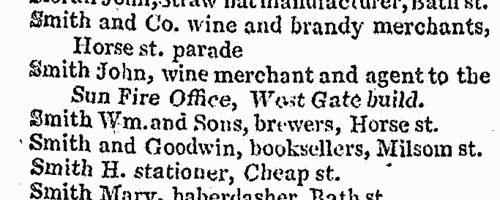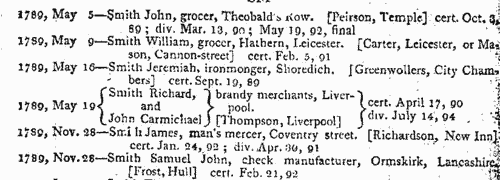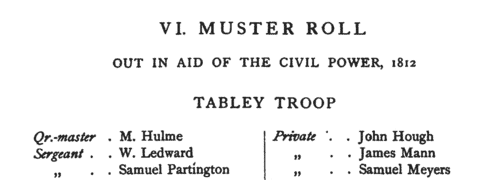Add this eBook to your basket to receive access to all 109 records. Our indexes include entries for the spelling ditchfield. In the period you have requested, we have the following 109 records (displaying 41 to 50): These sample scans are from the original record. You will get scans of the full pages or articles where the surname you searched for has been found. Your web browser may prevent the sample windows from opening; in this case please change your browser settings to allow pop-up windows from this site.  Apprentices registered in Northamptonshire
(1799) Apprentices registered in Northamptonshire
(1799)
Apprenticeship indentures and clerks' articles were subject to a 6d or 12d per pound stamp duty: the registers of the payments usually give the master's trade, address, and occupation, and the apprentice's name, as well as details of the date and length of the apprenticeship. There are central registers for collections of the stamp duty in London, as well as returns from collectors in the provinces. These collectors generally received duty just from their own county, but sometimes from further afield. The indentures themselves can date from a year or two earlier than this return. (The sample entry shown on this scan is taken from a Bristol return. Each entry has two scans, the other being the facing page with the details of the indenture, length of service, and payment of duty.) IR 1/69 | Sample scan, click to enlarge

| Tradesmen of Chester
(1392-1805)
Lists of admissions of freemen of the city of Chester from the earliest surviving records to 1805 were compiled by J. H. E. Bennett and published by the Lancashire and Cheshire Record Society from 1906. These lists were extracted from the mayoral yearbooks (dating back to 1392) and twelve freemen's rolls covering 1538 to 1612 and 1636 to 1805; and a list of admissions for 1505-1506 in Harleian MS 2105 (British Library). The record does not become more or less continuous until about 1490: in all, 12,426 freedoms are recorded. Freedom of the city, necessary to practise a trade in the city, could be obtained by birth (in which case the father's name and occupation are usually given); by apprenticeship to a freeman (the master's name and occupation being given); or by order of assembly. Both the freemen and the masters listed are indexed here. The main abbreviations used are: B, freedom taken up by right of birth; I, freedom taken up by right of indenture; M. B., Mayor's Book; *, freedom granted by order of assembly. | Sample scan, click to enlarge

| Inhabitants of Manchester, in Lancashire
(1805)
Holden's Triennial Directory of 1805 to 1807 included a provincial section, listing professional people and traders in England, Wales, Scotland and Ireland. (The sample scan here is from the listing for Bath) | Sample scan, click to enlarge

| Bankrupts
(1786-1806)
William Smith's abstracts of bankrupts, dividends and certificates for England and Wales from 1786 to June 1806. Bankruptcy causes abrupt changes in people's lives, and is often the reason for someone appearing suddenly in a different location or in a different occupation. | Sample scan, click to enlarge

| Bankrupts
(1806-1807)
William Smith's abstracts of bankruptcy certificates and dividends for England and Wales from July 1806 to December 1807. Bankruptcy causes abrupt changes in people's lives, and is often the reason for someone appearing suddenly in a different location or in a different occupation. | Sample scan, click to enlarge

| Bankrupts and solicitors
(1810)
English bankrupts and their solicitors, as reported in the European Magazine. July to December 1810.
| Sample scan, click to enlarge

| Cheshire Muster Roll: Knutsford Troop
(1812)
Muster roll of the Earl of Chester's Regiment of Cheshire Gentlemen and Yeomanry Cavalry, comprising six troops - Ashton Heyes, Knutsford, Macclesfield, Mere, Northwich and Tabley - called out 13 April 1812 and for the three following weeks to suppress disturbances in Macclesfield and Stockport. | Sample scan, click to enlarge

| Lichfield Directory
(1818)
The Staffordshire General and Commercial Directory was published by W. Parson and T. Bradshaw in 1818 in sections, 8 to 19 relating to towns in the centre of the county: 8. Abbots Bromley; 9. Burton-upon-Trent; 10. Cheadle; 11. Eccleshall; 12. Lichfield; 13. Longnor; 14. Penkridge; 15. Rugeley; 16. Stafford; 17. Stone; 18. Tamworth; 19. Uttoxeter. In each section the traders are listed alphabetically under surname, with occupation and address. | Sample scan, click to enlarge

| Staffordshire Villages Directory: Fotherley
(1818)
The Staffordshire General and Commercial Directory was published by W. Parson and T. Bradshaw in 1818 in thirty sections for the major towns, followed by lists for the separate villages. In each village the traders are listed alphabetically under surname, with occupation. | Sample scan, click to enlarge

| Workers at Appleton's Spinning Mill, Manchester
(1818)
The minutes of evidence taken before the Lords Committee on the Cotton Factories Bill include a series of reports by medical men as to the general health of the mill workers in April 1818. For each factory there is a complete list of workers, giving full name, age, how long employed in a factory, health (in general terms, such as 'Good' or 'Sickly'), and any chronic disease or 'distortion', cause and duration - with slight variations from report to report. The physicians examined several hundred people each day, asking such questions as 'Have you any swellings or sores anywhere?', 'Are your limbs straight?', 'Have you a good appetite for food?', 'Do you conceive yourself to be in good health?', and all concluded that the health of the mill workers was good, and that the workers were cheerful. This is the report for Peter Appleton and Co.'s cotton spinning mill. | Sample scan, click to enlarge

|
Research your ancestry, family history, genealogy and one-name study by direct access to original records and archives indexed by surname.
|












